4.2 Prokaryotes
Early Life on Earth
Prokaryotes were the first forms of life on Earth, appearing 3.5 to 3.8 billion years ago, and they existed for billions of years before plants and animals appeared. The Earth is around 4.54 billion years old. As already discussed, early Earth had a very different atmosphere from the one it has today. It contained less molecular oxygen and was subjected to strong radiation, so the first organisms would have flourished where they were more protected (such as in ocean depths or beneath the surface of the Earth). At this time, too, strong volcanic activity was common on Earth, so it is likely that these first organisms-the first prokaryotes–were adapted to very high temperatures.
Prokaryotic Diversity
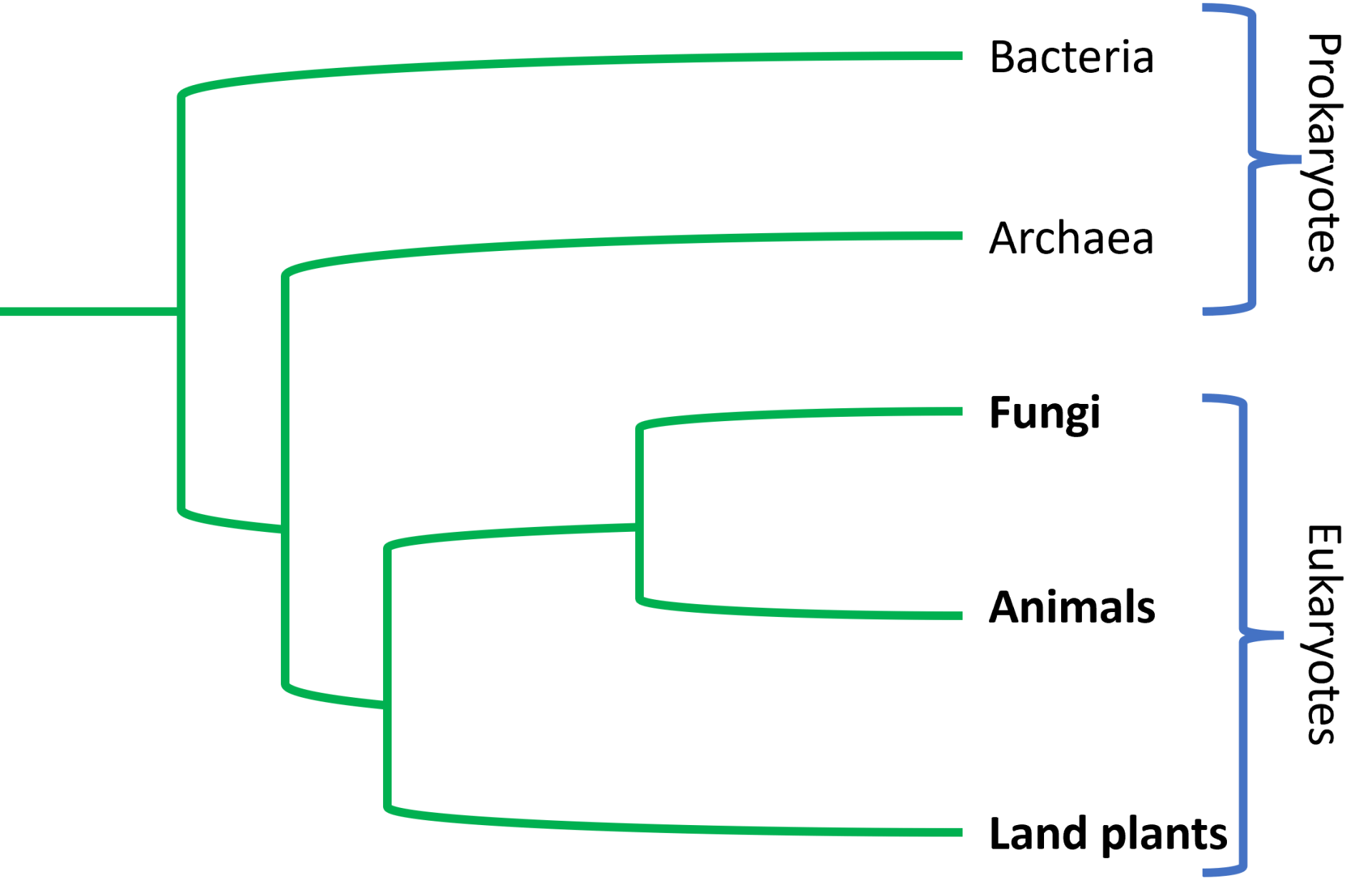
Prokaryotes are present everywhere. They cover every imaginable surface where there is sufficient moisture, and they live on and inside of other living things. There are more prokaryotes inside and on the exterior of the human body than there are human cells in the body. Some prokaryotes thrive in environments that are inhospitable for most other living things. Prokaryotes recycle nutrients—essential substances (such as carbon and nitrogen)—and they drive the evolution of new ecosystems, some of which are natural while others are man-made. Prokaryotes have been on Earth since long before multicellular life appeared.
The advent of DNA sequencing provided immense insight into the relationships and origins of prokaryotes that were not possible using traditional methods of classification. A major insight identified two groups of prokaryotes that were found to be as different from each other as they were from eukaryotes. These two groups, or domains, are the Bacteria and Archaea.
Microbial Mats

Microbial mats or large biofilms may represent the earliest forms of life on Earth; there is fossil evidence of their presence starting about 3.5 billion years ago. A microbial mat is a multi-layered sheet of prokaryotes (Figure 4.2.2) that includes mostly bacteria, but also archaea. Microbial mats are a few centimetres thick, and they typically grow where different types of materials interface, mostly on moist surfaces. The various types of prokaryotes that comprise them carry out different metabolic pathways, and that is the reason for their various colours. Prokaryotes in a microbial mat are held together by a glue-like sticky substance that they secrete, called extracellular matrix.
The first microbial mats likely obtained their energy from chemicals found near hydrothermal vents. A hydrothermal vent is a breakage or fissure in the Earth’s surface that releases geothermally heated water. With the evolution of photosynthesis about 3 billion years ago, some prokaryotes in microbial mats came to use a more widely available energy source—sunlight—whereas others were still dependent on chemicals from hydrothermal vents for energy and food.
Stromatolites
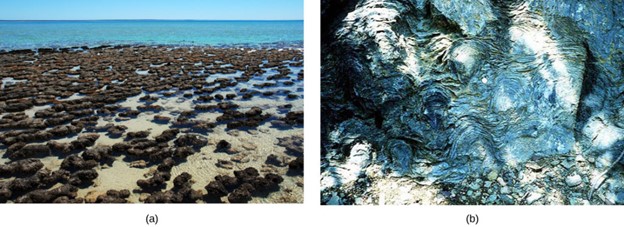
Fossilized microbial mats represent the earliest record of life on Earth. A stromatolite is a sedimentary structure formed when minerals are precipitated out of water by prokaryotes in a microbial mat (Fig. 4.2.3). Stromatolites form layered rocks made of carbonate or silicate. Although most stromatolites are artifacts from the past, there are places on Earth where stromatolites are still forming. For example, growing stromatolites have been found in the Anza-Borrego Desert State Park in San Diego County, California.
Life in Extreme Environments
Prokaryotes thrive in a vast array of environments: some grow in conditions that would seem very normal to us, whereas others are able to thrive and grow under conditions that would kill a plant or animal. Prokaryotes that grow under extreme conditions are called extremophiles, meaning “lovers of extremes.” Extremophiles have been found in extreme environments of all kinds, including the depths of the oceans, hot springs, the Arctic and the Antarctic, very dry places, deep inside Earth, harsh chemical environments, and high radiation environments. Extremophiles give us a better understanding of prokaryotic diversity and open up the possibility of the discovery of new therapeutic drugs or industrial applications. They have also opened up the possibility of finding life in other places in the solar system, which have harsher environments than those typically found on Earth. Because they have specialized adaptations that allow them to live in extreme conditions, many extremophiles cannot survive in moderate environments.
There are many different groups of extremophiles, and they are identified based on the conditions in which they grow best. Thermophiles are adapted for extreme heat (temperatures ranging from 60–80 °C). Acidophiles live in extremely acidic conditions (pH 3 or below). Halophiles live in extremely salty environments (salt concentration of at least 0.2 M).
One example of a very harsh environment is the Dead Sea, a hypersaline basin that is located between Jordan and Israel. Despite its name, the Dead Sea is not completely lifeless. While its extreme salinity (about 10 times saltier than the ocean) prevents fish, aquatic plants, and most macroscopic organisms from surviving, it is home to a variety of microorganisms specially adapted to these harsh conditions (e.g. halophiles).
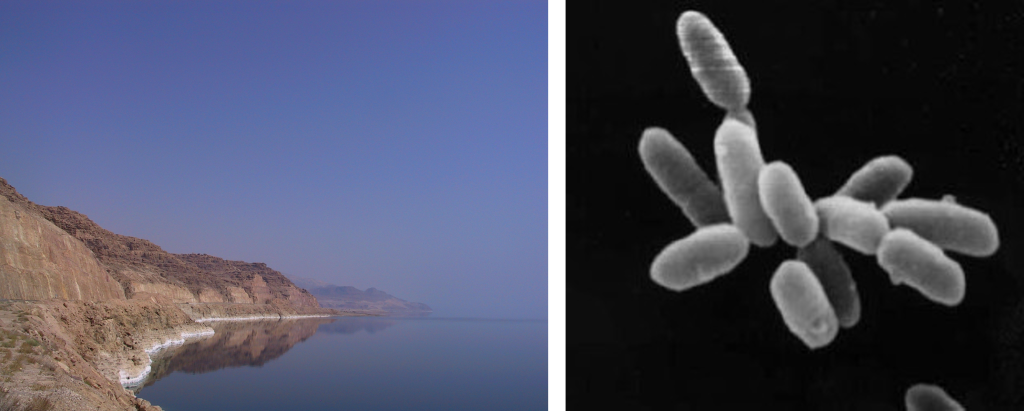
Prokaryotic Cell Structure
A prokaryotic cell is a simple, single-celled (unicellular) organism that lacks a nucleus or any other membrane-bound organelle. Prokaryotic DNA is found in the central part of the cell – a darkened region called the nucleoid (Fig. 4.2.5). Some structures are present in some prokaryotic species, but not in others. For example, the capsule found in some species enables the organism to attach to surfaces and protects it from dehydration. Some species may also have flagella (singular, flagellum) used for locomotion, and pili (singular, pilus) used for attachment to surfaces and to other bacteria for conjugation (see below). Plasmids, which consist of small, circular pieces of DNA outside of the main chromosome, are also present in many species of bacteria.
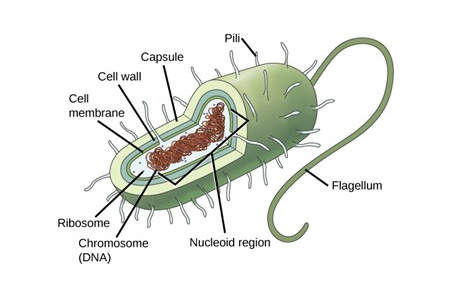
Most prokaryotes have a cell wall lying outside the plasma membrane. The composition of the cell wall differs significantly between the domains Bacteria and Archaea (and their cell walls also differ from the eukaryotic cell walls found in plants and fungi). The cell wall functions as a protective layer and is responsible for the organism’s shape.
Prokaryotes come in various shapes, but many fall into three categories: cocci (spherical), bacilli (rod-shaped), and spirilla (spiral-shaped) (Figure 4.2.6).
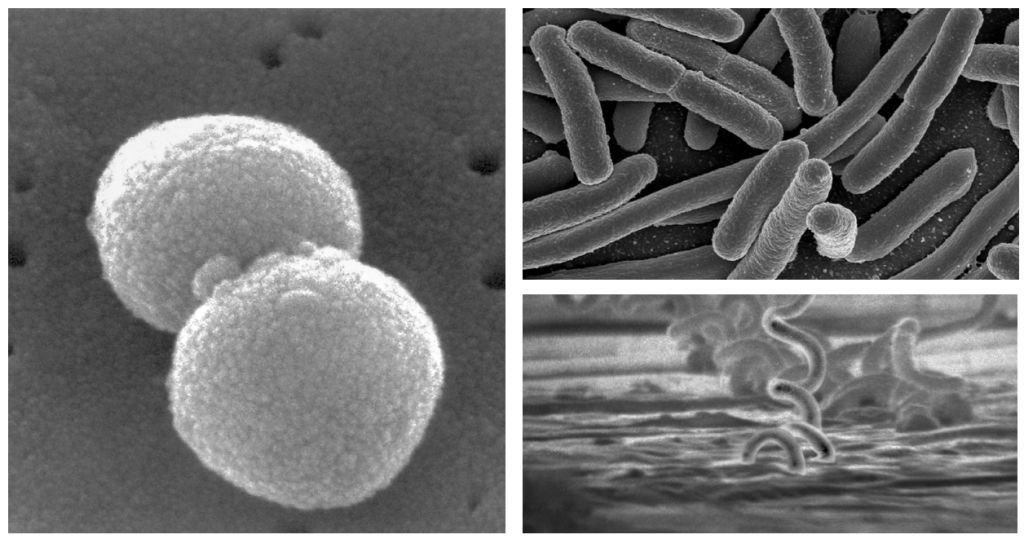
Reproduction
Reproduction in prokaryotes is primarily asexual and takes place by binary fission. Recall that the DNA of a prokaryote usually exists as a single, circular chromosome. Prokaryotes do not undergo mitosis. Rather, the chromosome loop is replicated, and the two resulting copies attached to the plasma membrane move apart as the cell grows in a process called binary fission. The prokaryote, now enlarged, is pinched inward at its equator, and the two resulting cells, which are clones, separate. Binary fission does not provide an opportunity for genetic recombination, but prokaryotes can alter their genetic makeup in three ways:
- In a process called transformation, the cell takes in DNA found in its environment that is shed by other prokaryotes, alive or dead. A pathogen is an organism that causes a disease. If a nonpathogenic bacterium takes up DNA from a pathogen and incorporates the new DNA in its own chromosome, it too may become pathogenic.
- In transduction, bacteriophages, the viruses that infect bacteria, move DNA from one bacterium to another. Archaea have a different set of viruses that infect them and translocate genetic material from one individual to another.
- During conjugation, DNA is transferred from one prokaryote to another by means of a pilus that brings the organisms into contact with one another. The DNA transferred is usually a plasmid, but parts of the chromosome can also be moved.
Cycles of binary fission can be very rapid, on the order of minutes for some species. This short generation time, coupled with mechanisms of genetic recombination, results in the rapid evolution of prokaryotes, allowing them to respond to environmental changes (such as the introduction of an antibiotic) very quickly.
Prokaryote Metabolism
Like all living things, prokaryotes need energy and carbon. They meet these needs in a variety of ways.
Energy metabolism in prokaryotes is classified as one of the following:
- Phototrophic organisms capture light energy from the sun and convert it into chemical energy inside their cells.
- Chemotrophic organisms break down either organic or inorganic molecules to supply energy for the cell.
In terms of carbon metabolism, prokaryotes are classified as either:
- Heterotrophic organisms use organic compounds, usually from other organisms, as carbon sources.
- Autotrophic organisms use carbon dioxide (CO2) as their only source or their main source of carbon. Many autotrophic bacteria are photosynthetic and get their carbon from the carbon dioxide in the atmosphere.
Prokaryotes have just about every possible combination of energy and carbon metabolism, but most are chemoheterotrophs, meaning that they depend on other organisms for both energy and carbon. Many break down organic wastes and the remains of dead organisms. They play vital roles as decomposers and help recycle carbon and nitrogen. Photoautotrophic prokaryotes are also common and are important producers. They are especially important in aquatic ecosystems.
Bacterial Diseases in Humans
Although many prokaryotes are harmless or even beneficial, some bacteria are capable of causing serious disease. These pathogenic bacteria disrupt normal body functions by producing toxins or invading and destroying tissues. They can spread through air, water, food, direct contact, or vectors like insects. These infections can affect nearly every part of the body. Many bacterial diseases are zoonotic, meaning they originate in animals and can be transmitted to humans.
Historically, bacterial diseases have caused some of the most catastrophic pandemics. One of the most devastating pandemics was the Black Death (1346 to 1361), a bubonic plague pandemic caused by the bacterium Yersinia pestis, which was carried by fleas living on black rats. The Black Death killed more than 100 million people and reduced the world’s population to about 350 to 375 million. Although modern antibiotics have made plague treatable, it still causes a few thousand cases globally each year.
Today, bacterial diseases remain a major global health concern, especially in regions with limited access to healthcare. However, modern science and public health measures have significantly reduced their impact. The primary methods for preventing bacterial disease are:
- Sanitation: Clean water, sewage treatment, and hygiene practices prevent the spread of many diseases.
- Antibiotics: These drugs target bacterial infections and are estimated to have saved hundreds of millions of lives since their widespread use in the mid-1900s. However, the rise of antibiotic resistance is now threatening these gains (see below).
- Vaccination: Some bacterial diseases, like tetanus and diphtheria, can be prevented with vaccines.
- Education and public health: Education is one of the most powerful tools in preventing bacterial disease. Through efforts led by organizations like the WHO, CDC, and UNICEF, public health education has helped reduce infections by promoting hand hygiene, safe food handling, proper antibiotic use, and clean water practices—saving countless lives worldwide.
In Canada, public health education has played a key role in addressing the rise of Lyme disease, a bacterial infection transmitted by black-legged ticks. As the range of these ticks expands due to climate change, organizations like the Public Health Agency of Canada and local health units have launched awareness campaigns to educate the public about tick prevention, safe outdoor practices, and early symptoms.
Educational efforts emphasize recognizing early symptoms, which typically appear within 3 to 30 days after a tick bite. These include a bull’s-eye-shaped rash, fever, chills, fatigue, headache, and muscle or joint pain. If left untreated, the infection can progress to more serious complications such as neurological issues, heart problems, and severe arthritis.
To prevent Lyme disease, public health messages encourage people to:
- Avoid tall grass and wooded areas where ticks are common
- Wear long sleeves and pants, and use insect repellents containing DEET
- Perform full-body tick checks after outdoor activities
- If a tick is found embedded (attached and feeding on the skin), remove it carefully with fine-tipped tweezers and seek medical attention for possible treatment or monitoring

The Antibiotic Crisis
In recent years, growing concern has emerged over what many call the antibiotic crisis – a situation where once-effective antibiotics are becoming less reliable due to the rise of antibiotic-resistant bacteria, or “superbugs.”
One of the main drivers of this crisis is the misuse and overuse of antibiotics. Antibiotics are often taken unnecessarily, such as for viral infections where they have no effect. They are also frequently taken improperly. For example, when patients stop treatment early, not all bacteria are eliminated. The ones that survive are often those with some level of natural resistance. These resistant bacteria then multiply and become more prevalent. This is a textbook example of natural selection at work.
A well-known example of antibiotic resistance is methicillin-resistant Staphylococcus aureus (MRSA). While S. aureus is a common bacterium that normally lives harmlessly on the skin or in the nose, MRSA is a dangerous strain that resists many commonly used antibiotics, including methicillin, penicillin, and amoxicillin. Initially confined to hospitals and long-term care facilities, MRSA has now spread into the general population, affecting otherwise healthy individuals in schools, gyms, and military settings.
The antibiotic crisis poses a serious threat to global health. Infections that were once easily treatable are becoming harder, and sometimes impossible, to cure. Surgeries, cancer treatments, and organ transplants all rely on effective antibiotics to prevent infection. Without them, modern medicine would be set back by decades.
To tackle this problem, we need to take several steps: use antibiotics more carefully in healthcare, avoid giving them when they’re not needed, control their use in farming, support the creation of new antibiotics, and teach people how to use them responsibly. Without urgent action, we risk entering a post-antibiotic era where even minor infections could once again become deadly.
Foodborne Diseases
We already mentioned that prokaryotes are everywhere. They readily colonize the surface of any type of material, and food is not an exception. Outbreaks of bacterial infection related to food consumption are common. A foodborne disease (colloquially called “food poisoning”) is an illness resulting from the consumption of food contaminated with pathogenic bacteria, viruses, or other parasites. In Canada, an estimated 4 million people—about 1 in 8—are affected by foodborne illness annually, leading to approximately 11,600 hospitalizations and 238 deaths (Public Health Agency of Canada, 2016).
The characteristics of foodborne illnesses have changed over time. In the past, it was relatively common to hear about sporadic cases of botulism, the potentially fatal disease produced by a toxin from the anaerobic bacterium Clostridium botulinum. A can, jar, or package created a suitable anaerobic environment where Clostridium could grow. Proper sterilization and canning procedures have reduced the incidence of this disease.
In Canada, most cases of foodborne illnesses are now linked to contaminated produce, undercooked meats, and cross-contamination during food preparation.
Beneficial Prokaryotes
Not all prokaryotes are pathogenic. On the contrary, pathogens represent only a very small percentage of the diversity of the microbial world. In fact, our life and all life on this planet would not be possible without prokaryotes.
Environmental Roles
Prokaryotes play a vital role in the environment. Some act as decomposers, breaking down dead plants and animals and recycling nutrients back into the soil. Others help plants grow by fixing nitrogen, meaning they take nitrogen from the air and turn it into a form that plants can use. There are also prokaryotes used in bioremediation, which means they help clean up pollution, such as oil spills or toxic waste, by breaking down harmful substances into safer ones.
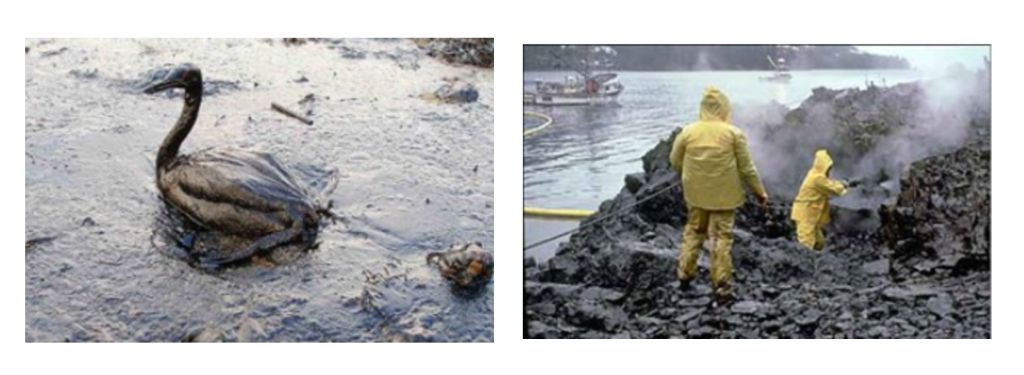
Food Production
Prokaryotes are often used in food production, especially in the making of many fermented foods. Bacteria are used to produce yogurt, cheese, and other dairy products. In pickling, they preserve vegetables like cucumbers and cabbage by creating an acidic environment that prevents spoilage. In cured meats, bacteria are used to ferment the meat, enhancing flavour and extending shelf life.

Human Microbiota
Humans live in close partnership with trillions of prokaryotes, forming what is known as the human microbiota. These microbial communities live on and inside our bodies, especially in the gut, where they help digest food, produce vitamins like vitamin K, support the immune system, and protect against harmful microbes. In fact, microbial cells in and on the human body outnumber human cells. While many of these microbes have mutualistic relationships with us (both sides benefit), others are commensal (they benefit without affecting us). Microbes also live on the skin, where they may help prevent infections. Scientists are still uncovering the full impact of these microbes on human health.
Knowledge Check
Text Description
- They were the first forms of life on Earth
- They require oxygen-rich environments to survive
- They lack DNA
- They evolved after eukaryotes
- Stromatolites
- Halophiles
- Thermophiles
- Acidophiles
- Budding
- Mitosis
- Binary fission
- Meiosis
- Creating muscle tissue in animals
- Digesting cellulose in human stomachs
- Producing light in deep-sea organisms
- Recycling nutrients by breaking down organic matter
- Overuse and misuse of antibiotics leading to resistant bacteria
- Genetic engineering of superbugs in labs
- Too few antibiotics are being used in hospitals
- Viruses adapting to antibiotic treatment
Answers:
- a. They were the first forms of life on Earth
- b. Halophiles
- c. Binary fission
- d. Recycling nutrients by breaking down organic matter
- a. Overuse and misuse of antibiotics leading to resistant bacteria
OpenAI. (2025). ChatGPT. [Large language model]. https://chat.openai.com/chat
Prompt: Create 5 multiple-choice questions using the following content
“Prokaryotes” from Introductory Biology: Ecology, Evolution, and Biodiversity by Erica Kosal is licensed under a Creative Commons Attribution-NonCommercial 4.0 International License, except where otherwise noted. Modifications: Edited and reworded
“13.1 Prokaryotic Diversity” from Biology and the Citizen by Colleen Jones is licensed under a Creative Commons Attribution 4.0 International License, except where otherwise noted. Modifications: Edited and reworded

